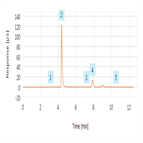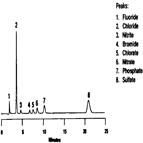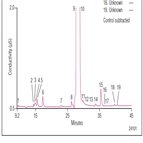Find methods for your needs
Refine by Feature
Displaying 1-3 of 3 results for Tag: caustic
AN72481: Trace Anions by Single Pass AutoNeutralization and Ion Chromatography (IC): Anions in 5% NaOH
Instrument Type: ICTrace anions determinations in caustic solutions require high dilution to minimize column overload by the caustic sample. However, the high dilutions required prevent analysis of trace anionic contaminants. Here a single pass approach to neutralize the base sample is demonstrated using both suppressors run in recycle mode. The run time was reduced from 45 min in the previous version of this application, AN 93 using “Park and AutoNeutralize” to 12 min. This application is demonstrated on a 5% (w/w) sodium hydroxide sample. An ICS-6000 can be used for this application.
AN51: Method for Determination of Anions in Sodium Hydroxide
Instrument Type: ICCaustic manufacturers need an accurate method to monitor the concentration of chlorate and other anions in their chlor-alkali processes. In chlor-alkali processes, chlorine and sodium hydroxide are produced by the electrolysis of a saturated brine solution. Monitoring the chlorate concentration ensures the process is working correctly. This method is used to determine the levels of anionic impurities in a 50% sodium hydroxide solution. Anions which can be determined by this method include chloride, nitrite, sulfate, phosphate, chlorate, and nitrate.
AU159: Determination of Volcanic Gases as Anions in Caustic Solutions Using AutoNeutralization, Automated Dilutions, and a Reagent-Free Ion Chromatography System
Instrument Type: ICThe type, amount, and ratios of volcanic gases characterize and can predict impending volcanic activity and its intensity. Changes in CO2 concentration, SO2-CO2 ratios, or halide gas composition may indicate impending volcanic eruptions. Previous analyses indicate that volcanic gases are primarily composed of CO2, water vapor, and SO2 with trace amounts of arsine and halide gases. The samples are diluted by AutoDilution to determine the major components as anions and neutralized by AutoNeutralization to determine the trace gases as anions.



